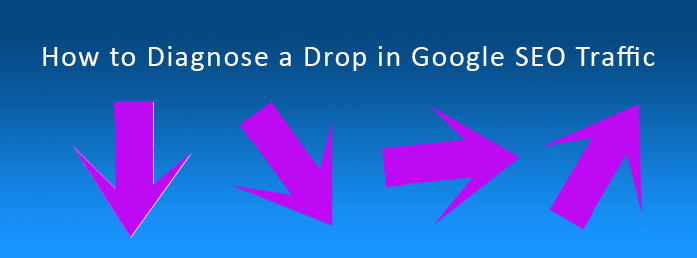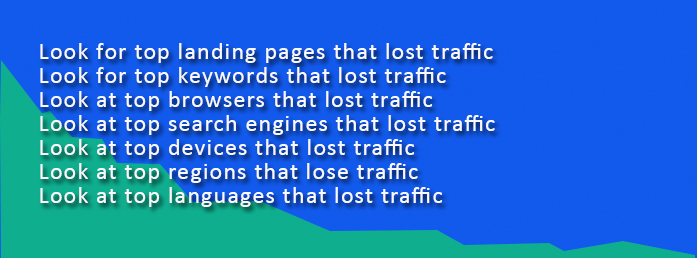In this post, John Lincoln teaches you how to diagnose a drop in website traffic fast.
When you see a significant drop in SEO traffic, most people start to worry. Their mind starts racing and they automatically dive into every analysis tool in the arsenal. Wouldn’t it be nice if you had a more systematic, calculated approach to evaluating the drop in traffic? Well, in this blog post we provide just that.
Watch a Video Or Read The Full Post Below
How to Diagnose a Drop in Google SEO Traffic
Here are general buckets of what could have caused your drop in SEO traffic.
Something wrong with your analytics program:
- Analytics tracking error
- Split testing error
- Code missing on a page
- Code incorrectly installed
- Etc.
Something to do with Google Algorithm or Webspam Team:
- Manual penalty
- Algorithm update
- Algorithm penalty
- Normal Google fluctuations
Something to do with Webmaster Tools:
- URL removal tool
- URL parameters
- Incorrect geo-targeting settings
- Etc.
Something wrong with your website:
Technical error on website (really the list is endless here)
- Robots.txt block
- No index no follow
- Duplicate content
- Incorrect rel canonical
- Incorrect redirects
- Etc.
So as we can see, there are a lot of issues that can cause a drop in SEO traffic. That is why people hire SEO companies like us to help. Here are a few of the steps we take when looking at a site that lost Google traffic.
Steps to Diagnose a Drop in SEO Traffic
Check your List of Changes to the Website
When you have a drop in SEO traffic, the first think you should do is check your list of changes to the website. If you are a larger company, you should keep a running list that is saved in Google Docs or at least annotated in Google Analytics. This way, you know if someone in another department made changes to the site that could hurt your SEO. Once you have that list in front of you, I recommend going through the process below.
Check your Analytics
The first thing you should do is to verify that your analytics is installed correctly, is working and hasn’t been recently jeopardized. In so many cases I see a website freaking out about what they think is a drop in organic search traffic, but instead, is an analytics tracking error.
If you verify it is not a tracking error, next check your analytics in the following ways.
Compare the period after the drop to before the drop for the following areas.
- Look for top landing pages that lost traffic
- Look for top keywords that lost traffic
- Look at top browsers that lost traffic
- Look at top search engines that lost traffic
- Look at top devices that lost traffic
- Look at top regions that lost traffic
- Look at top languages that lost traffic
Once you have done this comparison, you should have a pretty good idea of where you lost your traffic. Record this information, because we are not done yet.
Check your Webmaster Tools
If you haven’t read the ultimate guide I wrote on Webmaster Tools you can find that here. Certainly, everything in Webmaster Tools carries some value. But when trying to analyze a drop in SEO traffic, you should first look at the following metrics.
- Site Messages: Has Google sent you any important messages?
- Search Queries: How do the search queries look in Webmaster Tools? Do they correlate to the organic traffic data in Google Analytics? If things are way off, this could mean a tracking error in Analytics.
- Crawl Rate: Is Google crawling your site?
- Crawl Errors: Is Google having issues crawling the site and getting errors?
- Manual Actions: Do you have any manual actions?
- HTML Improvements: Do you have a large amount of duplicate content that ended up in the index?
- Google Index: Do you have a large drop or jump in pages in the index? Either could be bad for multiple reasons.
- Links to your Site: Check the links to your site, do you have any new links that look bad?
- Fetch as Googlebot: Are you having any issues fetching pages on your site, especially ones with drops in traffic by Googlebot or Googlebot mobile?
- Blocked URLs: Are there important URLs or images that are blocked by robots.txt?
- Sitemaps: Have your sitemaps been submitted? Are there any large glaring errors?
- URL Parameters: Has anyone recently set any new URL parameters in Webmaster Tools? Or has Google created any new ones on their own?
- Removal Tool: Has anyone used the URL removal tool?
- Disavow File: Has anyone recently uploaded a disavow file?
These are most of the questions you should ask yourself in Webmaster Tools.
Check your Ranking Tools – SEM Rush, Search Metrics, Moz
Any analytics program or rank-tracking tool can have errors. In fact, I have seen bad data in Google Analytics, Webmaster Tools, SEM Rush, Search Metrics and MOZ before. So that is very important to keep in mind, but if you use multiple tools to analyze a situation it is much less likely you will be operating on bad data. Our company uses all of these tools. Generally, if there is a drop in SEO traffic, these are some things you should look at.
- Visibility Index: Out of your top keywords that you are traffic, what is the average visibility?
- Keywords Per Page: How have your keyword rankings shifted on page 1, 2 and 3? Do you have more or less? What kinds of keywords have shifted? Do they related to specific pages on the site?
- Rankings Lost and Gained: Have there been any significant changes in the rankings lost or gained reports? What do those URLs look like? Is there a trend in the URLs? When you match that up to the recent changes on your website, does anything correlate?
- Local Rankings: Have the majority of your rankings shifted to one location for some reason? Or have you lost rankings in a specific area?
By looking at these reports, you can get a better idea of what is going on with your traffic.
Link Analysis, Majestic SEO, ahrefs, Opensite Explorer
Although we briefly looked at links in Webmaster Tools, it is not a bad idea to use a third party tool to get an even better picture of your backlink profile. For example, in Majestic SEO you might see that you have over 15% anchor text for a keyword. You can then look and see that you lost all of your traffic for that exact term. That screams Penguin Algorithm penalty. Along those same lines, you might see a large influx of links that could be negative SEO.
Summing Up Drops in SEO Traffic
When it comes to a drop in SEO traffic, always make sure to check your analytics first, your webmaster tools second, your website third and backlink profile fourth. Once you have done all of that, if you do not have an answer, you can check larger websites like seroundtable.com and searchengineland.com to see if there were any Google updates. Still having issues? Call Ignite Visibility and we’ll get you back on track.
Good luck!


